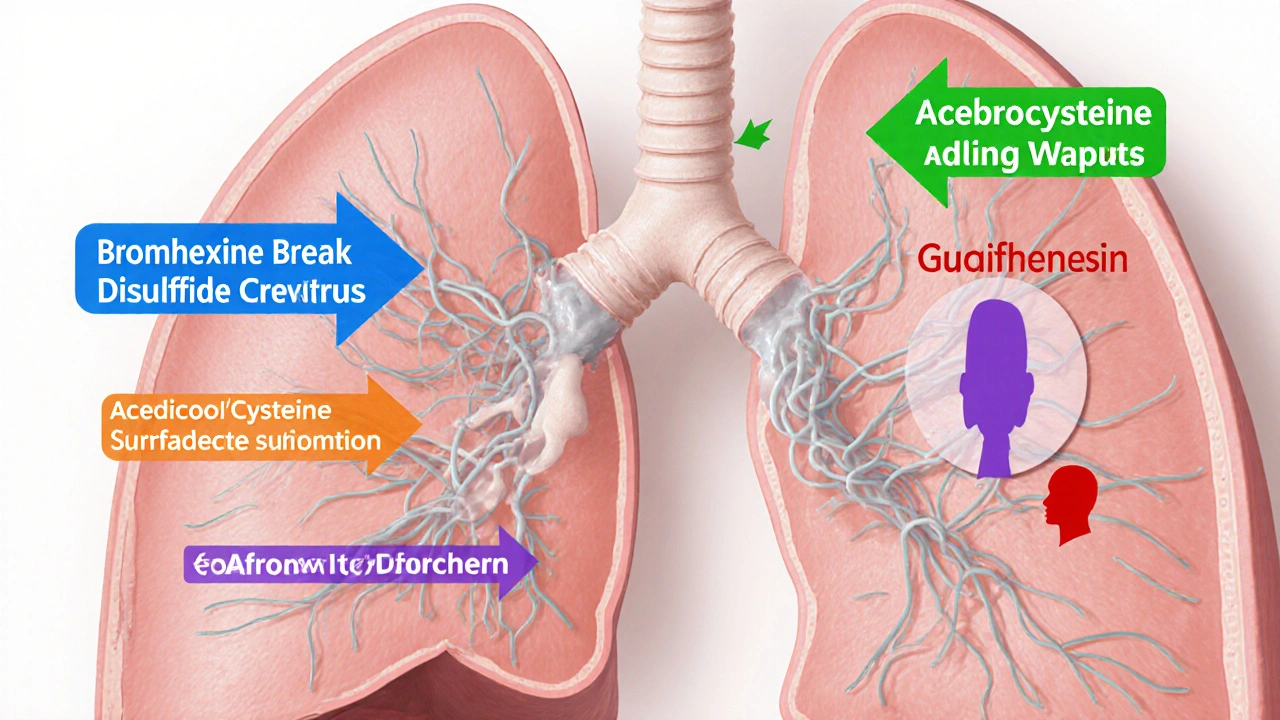Mucolytic Selection Guide
This tool helps you determine which mucolytic medication might be most appropriate for your cough based on symptoms and health conditions. Select your answers to get a personalized recommendation.
Step 1: Is your cough productive?
Productive cough means you're bringing up mucus.
Recommended Mucolytic
Key Takeaways
- Bromhexine works by thinning mucus, making it easier to clear from the airways.
- Acetylcysteine and ambroxol are the closest rivals in terms of efficacy and speed of action.
- Guaifenesin is an over‑the‑counter (OTC) option with a milder effect, while dextromethorphan targets cough reflex rather than mucus.
- Side‑effect profiles differ: bromhexine and ambroxol are generally well tolerated; NAC may cause strong odor and gastrointestinal upset.
- Choosing the right agent depends on the type of cough, underlying condition, age, and any drug interactions.
When a chesty cough won’t quit, most people reach for a “cough syrup”. But not all syrups work the same way. Some aim to suppress the cough reflex, others to thin the sticky mucus that triggers the urge to cough. Bromhexine Hydrochloride is a classic mucolytic that has been on pharmacy shelves for decades. It’s often compared with alternatives like acetylcysteine, ambroxol, carbocisteine, guaifenesin, and even dextromethorphan. This guide breaks down how each product works, who should use it, and what side effects to expect, so you can decide which option fits your situation best.
How Mucolytics Work: The Basics
A mucolytic’s job is simple: reduce the viscosity of respiratory mucus so cilia can move it out of the lungs more efficiently. By breaking down the protein‑rich network that makes sputum thick, these agents convert a stubborn plug into a watery fluid that’s easier to expectorate. The result is less irritation of the airway lining and a lower chance of secondary infections.
While the end goal is the same, each drug takes a slightly different biochemical route. Understanding those pathways helps explain why one may be preferred over another in certain clinical scenarios.

Side‑by‑Side Comparison
| Drug | Mechanism | Typical Adult Dose | Onset of Action | Common Side Effects | OTC Availability |
|---|---|---|---|---|---|
| Bromhexine Hydrochloride | Stimulates surfactant production; breaks disulfide bonds in mucus proteins. | 8mg three times daily (tablet) or 10mg/5mL syrup. | 30-60min | Nausea, mild skin rash. | Prescription in many countries; OTC in some EU markets. |
| Acetylcysteine (NAC) | \nReduces disulfide bridges, directly cleaving mucus polymers. | 600mg oral tablets 2-3×/day or 5-10mL nebulised solution. | 15-30min (neb.) | Bad breath, nausea, rare bronchospasm. | OTC in many regions (especially as a supplement). |
| Ambroxol | Metabolite of bromhexine; enhances surfactant secretion and ciliary beat frequency. | 30mg 2-3×/day. | 20-40min | Diarrhoea, taste alteration. | OTC in most European countries. |
| Carbocisteine | Modifies mucin glycoproteins, reducing viscosity. | 750mg 2-3×/day. | 45-60min | Stomach upset, skin rash. | Prescription‑only in many places. |
| Guaifenesin | Increases airway water content, loosening mucus. | 200‑400mg every 4h (max 2.4g/24h). | 1-2h | Dizziness, GI upset. | Widely OTC (US, Canada, AU). |
| Dextromethorphan | Acts on the cough centre in the medulla; not a mucolytic. | 10‑20mg every 4-6h (max 120mg/24h). | 30-60min | Drowsiness, nausea, potential for abuse. | OTC in most markets. |
Deep Dive into the Main Alternatives
Acetylcysteine (NAC)
Acetylcysteine is perhaps the most well‑known mucolytic, especially in hospital settings where it’s delivered via nebuliser. It directly attacks the disulfide bonds that hold mucus strands together, resulting in a rapid drop in viscosity. The oral form is handy for home use, but the taste can be off‑putting. Because NAC also replenishes glutathione, it doubles as an antioxidant, which can be a bonus for smokers or patients with chronic obstructive pulmonary disease (COPD).
When to choose NAC: Acute bronchitis with thick sputum, COPD exacerbations, or when a patient needs an antioxidant boost.
Things to watch: Strong sulphur‑like odor, possible bronchospasm after inhalation, and interaction with nitroglycerin (may increase hypotension).
Ambroxol
Ambroxol is essentially bromhexine’s active metabolite, so it shares many benefits but often feels a bit faster. It stimulates surfactant production more aggressively and has been shown to improve ciliary beat frequency, which means the lungs clear mucus even more efficiently.
Best for: Persistent coughs where patients feel the mucus is “stuck” despite using a standard expectorant.
Cautions: Can cause mild diarrhoea or a metallic taste; rare cases of allergic skin reactions.
Carbocisteine
Carbocisteine works by altering the structure of mucin proteins, making the mucus less sticky. It’s less potent than bromhexine or NAC, but its side‑effect profile is mild. It’s often prescribed for chronic bronchitis in Europe.
Ideal scenario: Long‑term management of chronic bronchitis where daily dosing is required.
Limitations: Slower onset; may not be sufficient for an acute, heavy‑producing cough.
Guaifenesin
Guaifenesin is the go‑to OTC expectorant in North America and Australia. Rather than ripping mucus apart at the molecular level, it hydrates airway secretions, thins them, and helps the cilia move the fluid outward. Because it’s mild, it’s safe for children over 4years and for most adults.
When it shines: Mild to moderate chesty coughs where the mucus isn’t extremely viscous.
Drawbacks: May require higher or more frequent doses to notice an effect; some people report dizziness.
Dextromethorphan (DXM)
DXM is not a mucolytic at all - it suppresses the cough reflex by acting on the central nervous system. It’s useful when the cough is dry and irritating, but it does nothing for thick sputum. Because of its abuse potential, many countries have placed purchase limits on high‑dose formulations.
Use it if: You have a dry cough that disrupts sleep and there’s no significant mucus.
Beware: Drowsiness, potential interactions with monoamine‑oxidase inhibitors, and the risk of misuse.

Decision Guide: Which Agent Fits Your Needs?
Picking the right product isn’t about “best overall” - it’s about matching the drug’s strengths to the patient’s situation. Below is a quick decision flow you can run in your head or with a pharmacist.
- Is the cough productive (producing sputum)?
- Yes → Go to step2.
- No → Consider a cough suppressant like dextromethorphan.
- How thick is the mucus?
- Very thick, tenacious → Strong mucolytic (Bromhexine, NAC, Ambroxol).
- Moderately thick → Guaifenesin or Carbocisteine.
- Do you need a rapid effect (within an hour)?
- Yes → Ambroxol or nebulised NAC.
- No → Oral Bromhexine or Carbocisteine works fine.
- Any special conditions?
- Asthma or bronchospasm risk → Avoid inhaled NAC; prefer oral Ambroxol or Bromhexine.
- Pregnancy/lactation → Guaifenesin is generally regarded as safe; always check with a doctor.
- Kid<12years → Guaifenesin (child‑specific dose) or pediatric‑approved Bromhexine syrup.
When in doubt, a pharmacist can help you weigh the pros and cons, especially if you’re on other medicines like anticoagulants or antihistamines.
Safety, Interactions, and Contra‑Indications
All mucolytics share a fairly benign safety profile, but a few interactions deserve attention:
- Bromhexine: May enhance the effects of other secretolytics; rarely interacts with anticholinergic drugs.
- Acetylcysteine: Contra‑indicated with nitroglycerin (can cause severe hypotension) and with active peptic ulcer disease (can irritate the stomach).
- Ambroxol: Caution in patients with hepatic impairment; dose adjustment may be required.
- Carbocisteine: Not recommended for patients with known hypersensitivity to the drug.
- Guaifenesin: Safe with most meds, but high doses can augment anticoagulant effects.
- Dextromethorphan: Avoid with MAO‑inhibitors, SSRIs, or tramadol due to serotonin syndrome risk.
Always read the label for age limits and dosage caps. If you’re pregnant, nursing, or have chronic liver/kidney disease, a quick chat with your healthcare provider is wise.
Frequently Asked Questions
Is bromhexine stronger than guaifenesin?
Yes. Bromhexine actively breaks down the protein bonds in mucus, while guaifenesin mainly adds water to thin secretions. For very thick sputum, bromhexine (or its metabolite ambroxol) will usually clear the airway faster.
Can I take bromhexine together with an antibiotic?
Generally, yes. In fact, many doctors prescribe bromhexine alongside antibiotics for pneumonia or bronchitis to improve mucus clearance. There are no major pharmacokinetic interactions, but always follow your doctor’s dosage instructions.
Is acetylcysteine safe for children?
Oral acetylcysteine is approved for children over 2years in many countries, but the taste can be unpleasant. Nebulised forms are used in pediatric intensive care under medical supervision.
Do mucolytics help with a dry cough?
No. If there’s little or no mucus, a mucolytic won’t do much. A cough suppressant like dextromethorphan or a simple honey‑lemon mix is more appropriate for a dry tickle.
Can I use bromhexine if I have asthma?
Yes, many asthma patients use bromhexine to clear mucus that can trigger bronchospasm. However, if you notice increased wheezing after starting the drug, stop and consult your doctor - rare cases of bronchial irritation have been reported.
Bottom line: there’s no one‑size‑fits‑all mucolytic. Bromhexine offers a solid balance of efficacy and tolerability, but alternatives like NAC, ambroxol, or guaifenesin may fit better depending on speed, side‑effect concerns, or OTC access. Use the decision guide above, check for interactions, and let a pharmacist or clinician confirm the final choice.







Beverly Pace
When you’re picking a medication, the first thing to consider is whether it aligns with a responsible approach to your health; self‑medicating without a doctor’s guidance can easily turn a simple cough into a bigger problem.
RALPH O'NEIL
For a productive cough, a mucolytic that works quickly-like ambroxol or nebulised NAC-can help clear the airways, while a dry cough is usually better served with a suppressant such as dextromethorphan.
Mark Wellman
So I was scrolling through the guide on mucolytics, and honestly, I feel like most people just treat these drugs like candy, not like the potent chemicals they are. First off, bromhexine isn’t just “some syrup”; it’s a surfactant‑stimulating agent that actually messes with mucus protein cross‑links, which means it can change the whole rheology of your sputum. If you’ve ever tried to cough up a rope‑like phlegm, you know that nothing short of a chemical loosener will do the trick. The article mentions ambroxol as a metabolite, but you can’t ignore that ambroxol’s half‑life is a bit longer, giving you a steadier effect over several hours. Also, NAC (acetylcysteine) is not just an antioxidant-when nebulised, it works in under twenty minutes, which is perfect for acute bronchitis. I get why the guide pushes a “one‑size‑fits‑all” calculator, but real patients have comorbidities, and you can’t just tick a box and expect miracles. Furthermore, the side‑effect profile of bromhexine is often under‑reported; nausea and a mild rash are common, and the taste can be pretty awful, especially if you’re already dealing with a sore throat. People with asthma need to be cautious because inhaled NAC can actually trigger bronchospasm, something the guide hints at but doesn’t stress enough. And let’s not even get started on drug interactions-anyone on warfarin should think twice before adding a mucolytic that can alter hepatic metabolism. In practice, I’ve seen patients on carbocisteine for weeks and wonder why their cough never fully resolves; the drug merely thins mucus a bit, but it doesn’t address the underlying inflammation. The guide’s decision flow is a decent starting point, but it should be coupled with a thorough clinical assessment, not just a questionnaire. Lastly, the “rapid effect” question is a bit misleading because rapid doesn’t always mean better; sometimes a slower, sustained release is what the lungs need to heal properly. So, while the tool is helpful, it’s definitely not a substitute for a doctor’s judgment. You should also consider patient preference; some people will never tolerate the taste of bromhexine and will stop the treatment prematurely. Overall, a personalized approach that weighs speed, side effects, and comorbidities will always beat a generic calculator.
Carl Boel
When you compare the pharmacodynamics of bromhexine to other mucolytics, you notice that its dual action-stimulating surfactant production while disrupting disulfide bonds-offers a uniquely American advantage in treating thick sputum without the pungent odor associated with NAC.
Shuvam Roy
It is essential to remember that each patient’s clinical picture is distinct; therefore, employing a stepwise assessment that incorporates mucus viscosity, urgency of relief, and any comorbid conditions will optimize therapeutic outcomes while minimizing adverse effects.
Jane Grimm
While the guide provides a concise tabular overview, the omission of dosage adjustments for hepatic impairment is a notable oversight that could lead to suboptimal dosing or toxicity in a subset of patients.
Nora Russell
One might argue that the inclusion of dextromethorphan in a mucolytic comparison is tantamount to placing a spoon beside a scalpel-certainly a decorative addition, but utterly misplaced in a serious clinical discourse.
Meghan Cardwell
In summary, bromhexine offers rapid mucolysis for thick secretions, ambroxol provides a slightly faster onset, NAC excels when nebulised, carbocisteine is suited for chronic management, and guaifenesin remains the go‑to OTC option for mild cases; selecting among them hinges on cough productivity, mucus thickness, speed of relief, and individual health considerations.
stephen henson
Great rundown! 👍🏽 If you’re deciding on the fly, just remember that a quick‑acting agent like ambroxol can shave minutes off the waiting game, which is especially handy for night‑time symptoms.
Mildred Farfán
Oh, look, another “one‑size‑fits‑all” flowchart-because we all love being told that a handful of radio buttons can replace a proper medical history, right?
Danielle Flemming
Hey folks! If you’re still stuck on choosing, think of it like picking a playlist: bromhexine is the heavy‑metal track that shreds the mucus, guaifenesin is the laid‑back acoustic song, and NAC is the high‑energy EDM drop for those emergency moments.